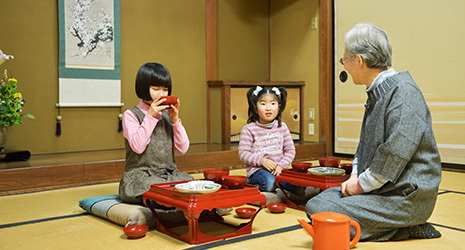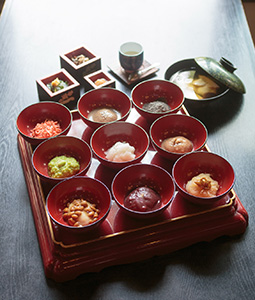Home > Highlighting JAPAN > Highlighting Japan November 2019 > Japan’s Food Culture
Highlighting JAPAN


The Deep Mochi Culture of Iwate
Mochi is a traditional Japanese food enjoyed around the country. In Iwate Prefecture, however, a unique mochi culture has developed and been passed down from generation to generation for some 400 years.
Mochi, which is traditionally prepared by steaming glutinous rice, pounding it in a wooden or a stone mortar until it becomes sticky, and rounding or flattening it, has been considered a sacred food since ancient times. Even today, eating or offering mochi is a custom associated with significant events such as the New Year or equinoctial week. In Iwate Prefecture, Ichinoseki City and Hiraizumi Town among other places have such a characteristic culture of mochi cuisine that they have a mochi calendar that requires local people to eat mochi on particular days throughout the year.
Ichinoseki and Hiraizumi was once the territory of the Sendai domain that ruled the stretch of land from what is now southern Iwate Prefecture to Miyagi Prefecture and northern Fukushima Prefecture during the Edo period (1603–1867). The first lord of the domain, Date Masamune, is known as an outstanding samurai general who laid the foundations of the domain’s prosperity with numerous policies.
According to Sato Koki, Chairman of the Ichinoseki Mochi Culture Promotion Council, “Based on an order from the Sendai domain, farmers were required to make mochi and offer it to the gods on Days 1 and 15 of every month. I think that it was one of the domain’s policies on cultural promotion featuring locally produced glutinous rice.” This habit subsequently extended to ordinary people as well. More than sixty days of mochi cuisine throughout the year, such as at the turning points in the seasons, were recorded on a mochi calendar.
“The culture of mochi cuisine originated from samurai culture, which places importance on etiquette. Even today, detailed etiquette exists for mochi cuisine on ceremonial occasions. Because my wife is from a different part of Sendai domain than I am, she was confused early on in our marriage,” says Sato.
The samurai class ate a dish called mochi honzen (full-course mochi dinner). Honzen is a formal dish for celebrations that is considered to originate from the etiquette of the samurai class during the Kamakura period (1185–1333). Although the Sendai domain complied with this protocol, it also invented mochi honzen, introducing dishes with mochi in them. Mochi honzen is accompanied by small dishes of zunda (sweet crushed edamame green soybeans) and june, which people eat by tossing ingredients such as perilla and numaebi (freshwater shrimps) with mochi, as well as zoni, which is soup with mochi in it. At a mochi honzen party, a person called the otorimochiyaku manages the party. After the otorimochiyaku says, “I am very happy to have all of you here today,” people enjoy eating their mochi meal while following instructions from the otorimochiyaku.
“Our food culture seems unique in the eyes of people in other regions. The local people said that mochi was everywhere around the country. But we came to consider that mochi culture in Ichinoseki and Hiraizumi could be said to be a local food culture that is peculiar to this region,” says Sato.
The Ichinoseki Mochi Culture Promotion Council, which was established in 2010 as a result of a call from Sato, sends out information on mochi culture in Ichinoseki and Hiraizumi to people inside and outside the region, and holds seminars to teach mochi culture through lectures and practice. Since 2012, the Council held the Nationwide Local Mochi Specialties Summit every year, at which event characteristic local mochi specialties are gathered from around the country. (The event is scheduled to be held under the new name of “Mochi Festival” in April 2020.) In 2016, Ichinoseki and Hiraizumi were designated as “SAVOR JAPAN” areas certified by the Ministry of Agriculture, Forestry and Fisheries as key areas that send information about traditional local food cultures overseas.
In recent years, mochi dishes in Ichinoseki and Hiraizumi, which were originally adorned with colorful seasonal ingredients, have included an even greater variety of ingredients including cheese, tomato and curry, and now number more than 300.
“Mochi dishes have become extremely casual. However, we would like to properly pass the background of the creation of the culture of mochi cuisine and our long-standing tradition to future generations,” says Sato.
At specialty restaurants and Japanese-style inns in Ichinoseki and Hiraizumi, you can eat casual mochi gozen (a bowl of mochi) or, if you make a reservation, authentic mochi honzen meals following the traditional etiquette, including a message from the otorimochiyaku.
I recommend visitors to Ichinoseki and Hiraizumi try to fully enjoy the 400-year history and culture of eating mochi as well as its flavor.
© 2009 Cabinet Office, Government of Japan







